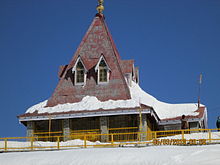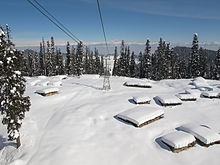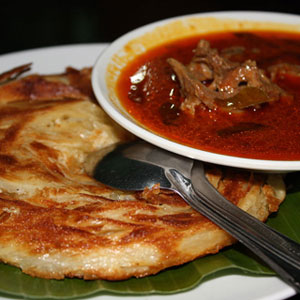
Gulmarg is a town, a hill station, a popular skiing destination and a notified area committee in the Baramula district of the Indian state of Jammu and Kashmir.
The town is situated in the Pir Panjal Range in the western Himalayas.
Gulmarg lies in a cup shaped valley in the Pir Panjal Range of the Himalayas, at an altitude of 2,650 m (8,694 ft), 56 km from Srinagar.The soil in Gulm

The resort was named Gulmarg ("meadow of flowers") by Sultan Yusuf Shah of the Chak Dynasty who frequented the place with his queen Habba khatoon in the 16th century.[2][3] Wild flowers of 21 different varieties were collected by the Mughal emperor Jahangir for his gardens in Gulmarg.[2][4] In the 19th century, British civil servants started using Gulmarg as a retreat to escape summers in North Indian plains. Hunting and golfing were their favorite pastime and three golf courses were established in Gulmarg including one exclusively for women.[5][4] One of the golf courses survives and at an altitude of 2,650 metres (8,690 ft) is the world's highest golf course. In 1927, British established a ski club in Gulmarg and two annual ski events were hosted one each during Christmas and Easter. Central Asian explorer Aurel Stein also visited Gulmarg during this period.[3] After the end of London colonial rule, Gulmarg became a part of the independent princely state of Jammu and Kashmir. To ensure the accession of the princely state, Pakistan planned an invasion of the state called Operation Gulmarg. One of the routes used by the invading militia of Pathan tribesmen, armed and supported by Pakistani regular troops, passed through the Haji Pir pass and Gulmarg onto the state capital Srinagar. Gulmarg fell to the invading army, but the Indian army led by the 1 Sikh Regiment, which had been airlifted to Srinagar only after the Dogra ruler of the state Maharaja Hari Singh had signed an Instrument of Accession with India on 26 October 1947, successfully defended the outskirts of Srinagar. Thereafter, Indian counterattacks pushed the tribesmen back and many towns including Gulmarg were recaptured.[10] In 1948, Indian Army established a ski school in Gulmarg which later became the High Altitude Warfare School of the Indian army specializing in snow–craft and winter warfare.[11] On 1 January 1949, the war ended under UN supervision and a Ceasefire line (CFL), which was rechristened the Line of Control (LOC) by the Shimla Agreement of 1972, came into being close to Gulmarg.[13] After Indian Independence, Indian planners sought to develop a destination for Winter sports in India. The Department of Tourism of the Government of India invited Rudolph Matt, in 1960 to select a suitable location for such purpose. Matt zeroed in on Gulmarg as suitable location for development of a Winter sports destination in India. In 1968, Institute of Skiing and Mountaineering was established in Gulmarg to train ski instructors. Over the next decade Indian planners invested ?30 million (US$450,000) to transform Gulmarg into a world-class ski destination. Gulmarg became a centre for skiers from Asian nations. In mid-1980s, heli-skiing was introduced in Gulmarg in collaboration with the Swiss skier Sylvain Saudan of Himalaya Heli-Ski Club of France.

Due to its high elevation, Gulmarg has a humid continental climate where the wet winter season sees heavy snowfall, especially for its latitude. Summers are moderate in temperature and length, whereas shoulder seasons are relatively cool.

Besides its astounding beauty, Gulmarg is a place of cultural extravaganza. The most popular cultural frenzy in Gulmarg is its Winter Festival. It comprises of various performances like traditional dances, songs, photography, athletics, band performances and adventure activities. Gulmarg is also known for the delicious spread of Kashmiri cuisine. If you are in Gulmarg, do not miss to taste a scrumptious portion of various gastronomical delicacies. Bag some beautiful traditional handicrafts, and their westernised versions as well, from the local markets in Gulmarg. Pick a rare souvenir and enrich your collection of authentic chattels.
According to CNN, Gulmarg is the "heartland of winter sports in India" and was rated as Asia's seventh best ski destination. The town is accessible from Srinagar by road via Tangmarg. The road climbs uphill in the last 12 kilometres to Gulmarg passing through forests of pine and fir. Winter sports like skiing, tobogganing, snowboarding and heli-skiing take place on the slopes of Mount Apharwat reachable by a Gondola lift.

Maharani Temple (commonly known as Shiv Temple of Gulmarg) was built by a Hindu ruler Maharaja Hari Sisodia for his wife Maharani Mohini Bai Sisodia who ruled till 1915. This temple was considered as the stately possession of Dogra Kings. The temple is dedicated to Shiva and Parvati. This temple is situated on a slight hill top with greenery. This temple is visible from all corners of Gulmarg.

The Roman Catholic St Mary's Church is located in the valley of Shepherds in Gulmarg. It was built in 1902, during the period of British rule, and was constructed
in a British style. Made of grey brick with a green roof and decorated wooden interior walls, it has been described as a "Victorian architectural wonder". In 1920
the church saw the wedding of the brother of Bruce Bairnsfather; Miss Eleanor Hardy Tipping married Capt. T. D. Bairnsfather, with newspapers describing the church
as "very prettily decorated" and with the service conducted by Rev Canon Buckwell in the presence of both organ and a full choir.
St Mary's was closed for years, but was renovated and reopened in 2003, holding its first Christmas service there for 14 years.The church belongs to the Diocese of
Amritsar, Church Of North India.

Built by the French company Pomagalski, the Gulmarg Gondola is one of the highest in the world reaching 3,979 metres. The two-stage ropeway ferries about 600
people per hour between Gulmarg and a shoulder of nearby Apharwat Peak (4,200 metres (13,800 ft)). The first stage transfers from Gulmarg at 2,600 metres (8,500 ft)
to Kongdoori at 3,080 metres (10,100 ft). The second stage which has 36 cabins and 18 towers, takes passengers to a height of 3,950 metres (12,960 ft) on the
Apharwat Peak 4,200 metres (13,800 ft). A chair lift system connects Kongdoori with Mary's shoulder for taking skiers to higher altitude. The high inflow of tourists
has had an effect on the fragile eco-system of Gulmarg and activists have demanded tighter regulation to save the environment of the area from over tourism.
An accident occurred on 15 June 2017 due to an enormous pine tree being uprooted by a gust of wind and breaking the perspex windows on one of the gondola cabins,
causing it to swing violently and its seven occupants to fall 100 ft (30 m) to the ground.
Situated at an altitude of 2,650 m, it is the highest green golf course in the world. The historic Gulmarg Golf Club was started in 1911 by the British who used the place as a holiday resort. The origin of Gulmarg as the golfing centre of India goes back to the late 19th century when a 6-hole course was made in 1890-91 by Colonel Neville Chamberlain. The first golf championship was played at Gulmarg in 1922. The Nedou's Cup was introduced in 1929.

Gulmarg trip by busis affordable and accessible. Travellers will enjoy a Gulmarg trip by bus. Buses are available to Gulmarg from Kashmir, Srinagar and other nearby towns. Jammu and Kashmir State Road Transport and other Private companies provide bus services to Gulmarg frequently. Have aGulmarg visit by buswith the help of HolidayIQ.

There is no directtrain to Gulmarg.Gulmarg has its closest railway station at Jammu. Jammu railway station is at a distance of 290 km from Gulmarg. Swarak Express, Himsagar Express, Jammu Rajdhani, and Andaman Express run in between most of the major railway stations. HolidayIQ provides details ofGulmarg train.Gulmarg train timetableis also available on the site of HolidayIQ.

There is noGulmarg airport.Srinagar is Gulmarg’s nearest domesticairport. There are many regularflights to Gulmargfrom most of the major cities in India. Travellers can hire prepaid cabs or shared taxis from the airport. They can also book cabs online to make their journey comfortable.
Adventure seekers will enjoy Gulmarg by road. From Srinagar, it will take 1 to 2 hours of a drive to Gulmarg.ReachingGulmarg by carthrough the winding paths and hairpin curves is fun and breathtaking at the same time. Visitors can self-drive or hire cars fromGulmargcar rental. It is better to contactGulmarg car rentaland book in prior to making your Gulmarg travel easier.

Most traditional dishes in Gulmarg are rice based and a typical meal consists of rice served with mutton, chicken or fish cooked with vegetables. Local specialties include Dum Aloo and Chaman, which is fried paneer in thick sauce. Rogan Josh, meat balls in gravy, is a very famous non-vegetarian dish throughout Kashmir. There are several dhabas that cater to your every meal-related need. And your trip to Gulmarg is incomplete without sampling the world-famous Kashmiri tea called Kahwa.